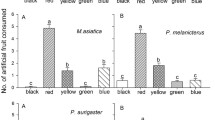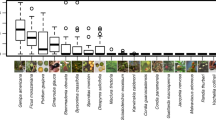Abstract
The colors of fruits and flowers are traditionally viewed as an adaptation to increase the detectability of plant organs to animal vectors. The detectability of visual signals increases with increasing contrasts between target and background. Contrasts consist of a chromatic aspect (color) and an achromatic aspect (light intensity), which are perceived separately by animals. To evaluate the relative importance of fruits’ chromatic and achromatic contrasts for the detection by avian fruit consumers we conducted an experiment with artificial fruits of four different colors in a tropical forest. We displayed the fruits against two different backgrounds, an artificial background and a natural one, because they differed in achromatic properties. We found no effect of the type of background on fruit detection rates. Detection rates differed for the four fruit colors. The probability of detection was explained by the chromatic contrast between fruits and their background, not by the achromatic contrasts. We suggest that birds attend primarily to chromatic contrast probably because these are more reliably detected under variable light conditions. Consistent with this hypothesis, we found habitat-specific differences in the conspicuousness of natural fruit colors in the study area. Fruits of understory species that are subjected to the variable light conditions within a forest displayed higher chromatic contrasts than species growing in the open restinga forest with constant bright illumination. There was no such difference for achromatic contrasts. In sum, we suggest that fruit colors differ between habitats because fruit colors that have strong chromatic contrasts against background can increase plants’ reproductive success, particularly under variable light conditions.




Similar content being viewed by others
References
Alves-Costa CP, Lopes AVF (2001) Using artificial fruits to evaluate fruit selection by birds in the field. Biotropica 33:713–717
Bernardi JVE, Landim PMB, Barreto CL, Monteiro RC (2005) Estudo especial do gradiente de vegetação do Parque Estadual da Ilha do Cardoso, SP, Brasil. Holos Environ 5:1–22
Burns KC, Dalen JL (2002) Foliage color contrasts and adaptative fruit color variation in a bird-dispersed plant community. Oikos 96:463–469
Endler JA (1990) On the measurement and classification of color in studies of animal color patterns. Biol J Linn Soc 41:315–352
Endler JA, Mielke PW (2005) Comparing entire colour patterns as birds see them. Biol J Linn Soc 86:405–431
Galetti M, Alves-Costa CP, Cazetta E (2003) Effects of forest fragmentation, anthropogenic edges and fruit color on the consumption of ornithocoric fruits. Biol Conserv 111:269–273
Giurfa M, Vorobyev M, Brandt R, Posner B, Menzel R (1997) Discrimination of coloured stimuli by honeybees: alternative use of achromatic and chromatic stimuli. J Comp Physiol 180:235–243
Hart NS, Partridge JC, Cuthill IC, Bennett ADT (2000) Visual pigments, oil droplets, ocular media and cone photoreceptor distribution in two species of passerine bird: the blue tit (Parus caeruleus L.) and the blackbird (Turdus merula L.). J Comp Physiol A 186:375–387
Kelber A (2005) Alternative use of chromatic and achromatic cues in a hawkmoth. Proc Roy Soc B 272:2143–2147
Kerner A (1895) The natural history of plants: their forms, growth, reproduction and distribution. Holt, New York
Loiselle BA, Blake JG (1991) Temporal variation in birds and fruits along an elevational gradient in Costa Rica. Ecology 72:180–193
Maier EJ (1992) Spectral sensitivities including the ultraviolet of the passeriform bird Leiotrix lutea. J Comp Physiol A 170:709–714
Marsden SJ, Whiffin M, Sadgrove L, Guimarães Jr. PR (2003) Bird Community composition and species abundance on two inshore islands in the Atlantic Forest region of Brazil . Ararajuba 11:181–187
Maynard-Smith J, Harper DGC (1995) Animal signals: models and terminology. J Theor Biol 177:305–311
Morden-Moore AL, Willson MF (1982) On the ecological significance of fruit color in Prunus serotina and Rubus occidentalis: field experiments. Can J Bot 60:1554–1560
Noffs MS, Baptista-Noffs LJ (1982) Mapa da vegetação do Parque Estadual da Ilha do Cardoso – As principais formações. Silvicultura em São Paulo 16:620–628
Oliveira-Filho AT, Fontes MAL (2000) Patterns of floristic differentiation among Atlantic forests in south-eastern Brazil and the influence of climate. Biotropica 32:793–810
Osorio D, Vorobyev M (1996) Color vision as an adaptation to frugivory in primates. Proc R Soc Lond B 263:593–599
Osorio D, Miklósi A, Gonda Z (1999) Visual ecology and perception of coloration by domestic chicks. Evol Ecol 13:673–689
Puckey HL, Lill A, O’Dowd DJ (1996) Fruit color choices of captive silvereyes (Zosterops lateralis). Condor 98:780–790
Schaefer HM, Schaefer V, Levey DJ (2004) How plant-animal interactions signal new insights in communication. TREE 19:577–584
Schaefer HM, Levey DJ, Schaefer V, Avery ML (2006) The role of chromatic and achromatic signals for fruit detection by birds. Behav Ecol 17:784–789
Schmidt V, Schaefer HM, Winkler H (2004) Conspicuousness, not color as foraging cue in plant-animal interactions. Oikos 106:551–557
Siitari H, Honkavaara J, Viitala J (1999) Ultraviolet reflection of berries attracts foraging birds. A laboratory study with redwings (Turdus iliacus) and bilberries (Vaccinium myrtillus). Proc Roy Soc Lond 266:2125–2129
Spaethe J, Tautz J, Chittka L (2001) Visual constraints in foraging bumblebees: flower size and color affect search time and flight behavior. Proc Natl Acad Sci 98:3898–3903
Summer P, Mollon JD (2000) Chromaticity as a signal of ripeness in fruits taken by primates. J Exp Biol 203:1987–2000
Traveset A, Willson MF (1998) Ecology of the fruit-color polymorphism in Rubus spectabilis. Evol Ecol 12:331–345
Troost JM (1998) Empirical studies of color constancy. In: Walsh V, Kulikowski J (eds) Perceptual constancy, Cambridge University Press, Cambridge, pp 262–282
Vorobyev MR, Osorio D (1998) Receptor noise as a determinant of color thresholds. P Roy Soc B 265:351–358
Vorobyev M, Brandt R, Peitsch D, Laughlin SB, Menzel R (2001) Color thresholds and receptor noise: behaviour and physiology compared. Vision Res 41:639–653
Wheelwright NT, Janson CH (1985) Colors of fruit displays of bird-dispersed plants in two tropical forests. Am Nat 126:777–799
Whelan CJ, Willson MF (1994) Fruit choice in migrating North American birds: field and aviary experiments. Oikos 71:137–151
Whitney KD (2005) Linking frugivores to the dynamics of a fruit color polymorphism. Am J Bot 92:859–867
Willson MF, Graft DA, Whelan CJ (1990) Color preferences of frugivorous birds in relation to the colors of fleshy fruits. Condor 92:545–555
Willson MF, Whelan CJ (1990) The evolution of fruit color in fleshy-fruited plants. Am Nat 136:790–809
Willson MF, Comet TA (1993) Food choices by northwestern crows: experiments with captive, free-ranging and hand-raised birds. Condor 95:596–615
Acknowledgments
We would like to thank P. Guimarães Jr. for help in statistical analysis and comments on the manuscript, V. G. Staggemeier for fieldwork assistance and the Instituto Florestal for permission to work in the study site. This project received financial support from FAPESP (Proc. 05/52726-9). E.C. thanks FAPESP (Proc. 03/08447-2) and M.G. receives a fellowship from CNPq. E.C. and H.M.S. received a DAAD fellowship during data analysis and writing of the manuscript. H.M.S. was also supported by DFG grant (Scha 1008/4-1) during this project.
Author information
Authors and Affiliations
Corresponding author
Rights and permissions
About this article
Cite this article
Cazetta, E., Schaefer, H.M. & Galetti, M. Why are fruits colorful? The relative importance of achromatic and chromatic contrasts for detection by birds. Evol Ecol 23, 233–244 (2009). https://doi.org/10.1007/s10682-007-9217-1
Received:
Accepted:
Published:
Issue Date:
DOI: https://doi.org/10.1007/s10682-007-9217-1




